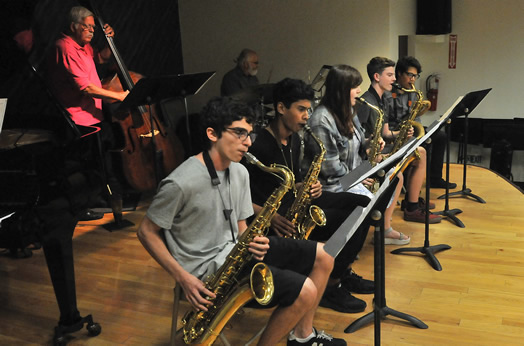Allegro
Woodwind doubling is an art
Volume 116, No. 12December, 2016
“Some days you get up and put the horn to your chops and it sounds pretty good and you win. Some days you try and nothing works and the horn wins. This goes on and on and then you die and the horn wins.” – Dizzy Gillepsie
In today’s musical landscape, audience perceptions are changing as economics play a more controlling role in what does or does not reach commercial consumption. For musicians, versatility becomes paramount. No one understands that better than the woodwind doubler, tasked with being able to play many different instruments in a given performance.
Early this fall, Music for a Sound Future and the Council for Living Music presented a free educational clinic on the art of woodwind doubling, led by member and woodwind artist Ed Joffe. Music students from LaGuardia High School and Purchase College were invited to participate in this special clinic held in the Local 802 Club Room, allowing them a rare opportunity to learn from and play with New York professional woodwind doublers – a perfect introduction to Local 802, the home of live music.

Young musicians from LaGuardia High School performed at a recent clinic at Local 802 on the art of woodwind doubling, led by Local 802 member Ed Joffe. Photo: Walter Karling.
First, the sax section from the LaGuardia High School Senior Jazz Band (under the direction of 802 member Kevin Blancq) played an excerpt from a big band arrangement of “Lullaby of Leaves,” accompanied by Local 802 members Allen Farnham (piano), John Beal (bass) and Paul Pizzuti (drums). An excited audience of students, professionals and woodwind enthusiasts listened and watched as these talented high schoolers eagerly absorbed Joffe’s salient comments and critiques on technique, style and sound production. After only 20 minutes of coaching, the improvement in their playing was remarkable. Blancq was ecstatic about the clinic. He told us, “This has been a wonderful experience for my students. Thank you!”
Next, the members of the Purchase Jazz Orchestra Saxophone Section took the stage to perform an intricate arrangement of the Thad Jones and Mel Lewis piece “Consummation,” which contained some complicated doubles. Their teacher, the renowned jazz trumpeter and Local 802 member Jon Faddis, was in the audience offering support and encouragement. Again Joffe provided pointed comments about embouchure and practicing techniques, all of which improved the fluidity of their performance. Joffe stressed the importance of practicing the actual switch of instruments in a given piece, examining the physical and mental preparation required for the next instrument change. It’s all in the timing.
Joffe went on to describe the woodwind doubler as the “decathlonist” of the instrumental world – a perfect analogy. Not only do these multi-instrumentalists have to master the clarinet, saxophone, flute, oboe and bassoon – including all their associated doubles – but, have equal facility in multiple musical styles.
The clinic continued as the rhythm section was joined by a section of professional Local 802 woodwind doublers: Dustyn Richardson, Julie Pacheco, Matt Lepek, Neil Johnson and Devin DiMauro. These professionals shared valuable performance-enhancing tips, demonstrating that there is always room for improvement, no matter how seasoned a player you are.
Throughout the event, audience members asked questions about reeds and technique. But the emphatic question remained: How do you find the time required to practice all these instruments? The basic answer: It takes discipline and efficient time management. An impassioned Joffe spoke from the heart: “You have to love the music; you have to love the doubles; otherwise there would be no way to accomplish this seemingly daunting task.”
Perhaps the most noticeable characteristic of the evening was the strong sense of collegial musical community and camaraderie that was shared by everyone in the room. The students were able to participate in the best the union has to offer – a valuable educational clinic led by a superb teacher with the assistance of talented Local 802 musicians surrounded by supportive colleagues, teachers and observers all in the pursuit of making great music even better. Now that’s what I’m talking about!
